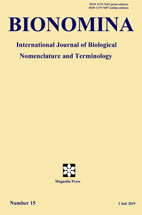Abstract
In the scientific literature, the availability, authorship, date and onomatophore of the four generic nomina of lizards "Platydactyles", "Hemidactyles", "Thecadactyles" and "Ptyodactyles" published by Cuvier (1816) and of the genus nomen of toads "Otilophes" published by Cuvier (1829) as French scientific nomina in the plural, and of their latinised forms, are credited to various authors. After a careful analysis, these nomina are here attributed respectively to Goldfuss (1820) for Platydactylus, Hemidactylus, Thecadactylus and Ptyodactylus, to Wagler (1830) for Otilophus and to Tschudi (1838) for Osilophus. Solutions are proposed to various other nomenclatural problems related to these and related nomina. Attention is drawn again to the fact that the Code’s Rules concerning specific epithets and generic substantives being ‘unmodified vernacular words’, as well as those distinguishing ‘unjustified emendations’ from ‘incorrect subsequent spellings’ are deficient. In order to solve all these nomenclatural cases, we had to resort to 20 Articles of the Code (3.2, 11.2, 11.3, 11.6, 11.7, 11.8, 21.2, 21.3, 23.9, 24.2, 30.2, 32.5, 33.2, 33.3, 35.4, 40.2, 50.1, 57.3, 67.8 and 68.3) and to 59 technical nomenclatural terms. This highlights the fact that nomenclatural problems concerning old nomina cannot be properly dealt with in a hurry and without a good, but also critical, knowledge of the Code, and that the use of a more detailed terminology than that of the Code facilitates such a work.

